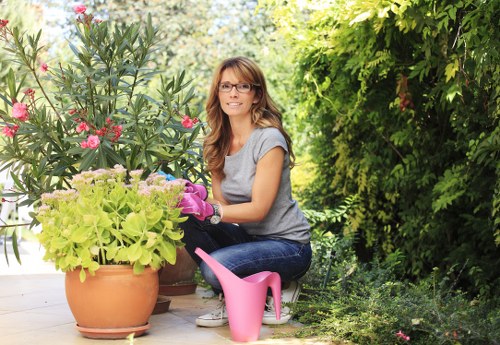Garden Fence Replacement in Landscape Gardeners
Why Replace Your Garden Fence?

Garden fences are integral to the aesthetics and functionality of any landscape gardener's design. Over time, fences can deteriorate due to weather conditions, pests, and general wear and tear. Replacing your garden fence not only enhances the visual appeal of your garden but also ensures security and privacy.
Choosing the right time for fence replacement is crucial. Spring and fall are ideal seasons as the weather is mild, allowing for easier installation and curing of materials. Additionally, timely replacement can prevent further damage to your garden’s landscape.
Investing in a new fence can increase the overall value of your property. A well-maintained fence adds to the curb appeal and makes your garden a more enjoyable and functional space for family and guests.
Types of Garden Fences

There are various types of garden fences to choose from, each offering different benefits. The most common types include wooden, vinyl, metal, and composite fences. Wooden fences are popular for their natural look and versatility, while vinyl fences are known for their durability and low maintenance.
Metal fences, such as wrought iron or aluminum, provide a classic and elegant appearance, often used for decorative purposes. Composite fences, made from a mix of wood and plastic, offer the aesthetics of wood with the durability of plastic, making them a great long-term investment.
When selecting a fence type, consider factors like climate, maintenance requirements, and the specific needs of your garden. For instance, if you have a high-traffic garden area, a sturdy metal fence might be more appropriate, whereas a wooden fence can complement a rustic garden theme.
Steps to Replace a Garden Fence

Replacing a garden fence involves several key steps to ensure a successful installation. First, assess the existing fence to determine the extent of replacement needed. Remove any damaged or rotten sections carefully to avoid disrupting the surrounding landscape.
Next, choose the appropriate materials based on the type of fence you’re installing. Measure the perimeter of your garden accurately to calculate the amount of materials required. Ensure you have all necessary tools and supplies before beginning the replacement process.
Installation typically starts with setting new fence posts securely into the ground. This step is crucial for the stability and longevity of the fence. Once the posts are in place, attach the fence panels or boards, ensuring they are level and evenly spaced. Finish the installation by adding any decorative elements or protective coatings as needed.
Maintenance Tips for Longevity

Regular maintenance is essential to prolong the life of your garden fence. Inspect your fence periodically for signs of wear, such as cracks, rust, or loose boards. Addressing minor issues promptly can prevent them from escalating into major problems that require extensive repairs.
Cleaning your fence regularly removes dirt, mold, and other contaminants that can degrade the material over time. For wooden fences, apply a protective sealant or paint to shield the wood from moisture and pests. Metal and vinyl fences may require less maintenance but still benefit from occasional cleaning to maintain their appearance.
Proper upkeep not only extends the life of your fence but also ensures it continues to contribute positively to your garden’s overall design. A well-maintained fence is a testament to your commitment to a beautiful and functional outdoor space.
Choosing the Right Professional

Selecting the right landscape gardener or fencing professional is crucial for a successful fence replacement project. Look for experienced professionals with a proven track record in fence installation and replacement. Check reviews and ask for references to ensure you’re hiring a reliable and skilled contractor.
Discuss your specific needs and preferences with the professional to ensure they understand your vision for the garden. A good landscaper will offer valuable advice on the best materials and designs to complement your existing landscape.
Obtain multiple quotes to compare pricing and services offered. While it’s important to stay within your budget, prioritize quality and expertise over the lowest price to ensure a durable and aesthetically pleasing fence replacement.
Benefits of Upgrading Your Fence
Enhanced Aesthetics
A new fence can significantly transform the look of your garden. Modern designs and materials offer a wide range of styles to match any landscape theme, from traditional to contemporary. Upgrading your fence allows you to refresh your garden’s appearance and keep it in line with current trends.
Improved Security
Older fences may have vulnerabilities that compromise the security of your property. Replacing your garden fence with a sturdier material can deter intruders and protect your garden from unwanted pests or animals. Enhanced security features, such as taller fences or those with tighter gaps, provide additional peace of mind.
Increased Property Value
A well-maintained and attractive fence boosts the overall value of your property. Potential buyers are often attracted to homes with aesthetically pleasing and functional outdoor spaces. Investing in fence replacement is not only an improvement for your current enjoyment but also a smart financial decision for the future.
Contact us today to schedule a consultation and transform your garden with a beautiful new fence.
Choosing the Right Materials
Wood
Wooden fences are favored for their natural beauty and versatility. They can be painted or stained in various colors to match your garden’s palette. However, wooden fences require regular maintenance to prevent rot, warping, and pest infestations.
Vinyl
Vinyl fences are low-maintenance alternatives to wood, resistant to weathering and pests. They come in a variety of styles and colors, maintaining their appearance without the need for frequent painting or sealing.
Metal
Metal fences, such as aluminum or wrought iron, offer durability and security. They are highly resistant to weather conditions and can be designed with intricate patterns for a decorative touch.
Composite
Composite fences combine the strengths of wood and plastic, offering a durable and eco-friendly option. They are resistant to rot and pests, requiring minimal maintenance while providing a natural wood-like appearance.
Cost Considerations
Material Costs
The cost of fence replacement varies depending on the material chosen. Wood is generally the most affordable option, while metal and composite materials tend to be more expensive. Vinyl falls somewhere in between, offering a balance between cost and durability.
Installation Fees
Professional installation fees can also impact the overall cost of fence replacement. Experienced landscapers may charge higher rates, but their expertise ensures a quality installation that lasts longer and performs better.
Maintenance Expenses
Consider the long-term maintenance costs associated with each fence material. While some materials require more upkeep, others, like vinyl or composite, offer low-maintenance solutions that save time and money over the fence’s lifespan.
Book your service now to get a detailed quote tailored to your garden’s specific needs.
Environmental Impact
When replacing your garden fence, consider the environmental impact of your material choice. Sustainable materials like composite or recycled metal reduce waste and minimize your garden’s ecological footprint. Additionally, opting for long-lasting materials decreases the frequency of replacements, conserving resources.
Proper disposal of old fencing materials is also important. Many professional landscapers offer eco-friendly disposal options, ensuring that retired fences are handled responsibly.
Choosing environmentally friendly materials not only benefits the planet but also aligns with modern landscaping trends that prioritize sustainability and eco-conscious practices.
Color and Design Options
Choosing the Right Color
Color plays a significant role in the overall look of your garden fence. Neutral tones like white, black, and natural wood colors are versatile and can complement any garden style. Bold colors, on the other hand, can make a statement and become a focal point in your landscape design.
Design Styles
Fence designs range from simple and functional to ornate and decorative. Slatted fences offer a modern look, while picket fences provide a classic charm. Decorative metal fences can add elegance and sophistication, enhancing the visual interest of your garden.
Customization
Customizing your fence allows you to incorporate unique elements that reflect your personal style. Incorporate lattice panels, finials, or decorative post caps to add character and individuality to your garden fence.
Contact us today to explore various color and design options that perfectly match your garden’s aesthetic.
Permits and Regulations
Before initiating a fence replacement project, it’s essential to check local regulations and obtain any necessary permits. Fence height restrictions, boundary lines, and material guidelines can vary depending on your location. Compliance with these regulations ensures a smooth installation process and avoids potential legal issues.
Consult with your local planning or zoning department to understand the specific requirements for fence replacement in your area. Additionally, discuss any rules with your landscape gardener to ensure they are aware of and adhere to these guidelines during installation.
Proper planning and adherence to regulations contribute to a hassle-free fence replacement experience, allowing you to enjoy your updated garden without complications.
Integrating Fence with Landscape Design
Complementary Plantings
Integrate your new fence with complementary plantings to create a harmonious landscape design. Climbing plants like vines or roses can enhance the appearance of your fence, adding greenery and color to your garden.
Lighting
Incorporate lighting elements into your fence design to enhance both aesthetics and functionality. Solar-powered lights or LED fixtures can illuminate your garden at night, highlighting the fence and creating a welcoming atmosphere.
Functional Additions
Add functional elements like trellises, gates, or storage areas to your fence to maximize its utility. Gates provide easy access to your garden, while trellises can support climbing plants and add vertical interest.
Book your service now to seamlessly integrate your new fence into your overall landscape design.
Common Mistakes to Avoid
- Poor Planning: Failing to plan adequately can lead to issues like improper measurements or selecting unsuitable materials.
- Ignoring Local Regulations: Not adhering to local zoning laws and permit requirements can result in fines or the need to modify your fence after installation.
- Underestimating Costs: Not accounting for all expenses, including materials, labor, and maintenance, can stretch your budget.
- Neglecting Maintenance: Skipping regular upkeep can shorten the lifespan of your fence and diminish its appearance.
By avoiding these common mistakes, you ensure a successful garden fence replacement that meets your aesthetic and functional needs.
Conclusion
Garden fence replacement is a significant project that enhances the beauty, security, and value of your landscape. By selecting the right materials, adhering to local regulations, and integrating the fence seamlessly with your garden design, you can achieve a stunning and functional outdoor space.
Partnering with experienced landscape gardeners ensures a smooth and professional installation process. Regular maintenance and thoughtful design choices will keep your fence looking great and serving its purpose for years to come.
Contact us today to begin your garden fence replacement journey and transform your outdoor space into a picturesque and secure environment.